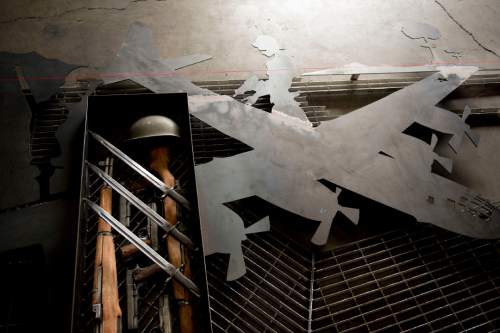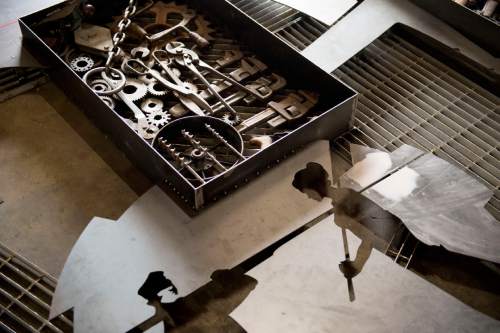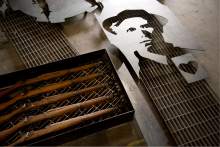This is an archived article that was published on sltrib.com in 2016, and information in the article may be outdated. It is provided only for personal research purposes and may not be reprinted.
A likeness of Joe Hill, the labor icon who was executed in Salt Lake City after his controversial murder conviction more than a century ago, will be included in a new art installation that celebrates 10,000 years of labor history in Utah.
The installation, a mural-like sculpture that will adorn the side of a new building at the corner of 900 S. 200 West, features scenes from Utah's history dating as far back as the earliest known human inhabitants. It highlights significant events, such as the arrival of Mormon pioneers and the completion of the transcontinental railroad, and represents World War II with a "Rosie the Riveter" figure next to the Enola Gay and two mushroom clouds.
"We were trying to cram a whole ton of things into it," said Mark Hofeling, the artist commissioned by Atlas Architects to create the piece. Salt Lake City's Redevelopment Agency gave the project $15,000 after it was approved by the agency's board. The piece will be mounted in the next few weeks.
Hofeling said the location of the sculpture raised some concern — John G. Morrison, the man Joe Hill was convicted of killing, lived across the street from where the piece is to be placed. But Hofeling said Hill can't be excluded from an artwork that depicts labor history in the state.
"It happened. His execution is a part of our history and we can't expunge it," Hofeling said.
Hill became a well-known songwriter for the radical labor movement known as the Industrial Workers of the World and came to Utah in 1913. In 1914, he was convicted of shooting Morrison, a Salt Lake City grocer, and he was executed the next year. Critics of Hill's conviction point out the prosecution was based nearly solely on circumstantial evidence.
Vandals last year painted over a mural that depicted Hill on the wall of a union hall just a few blocks away. Members of the RDA committee that approved the new piece said they aren't specifically concerned about similar acts of vandalism.
"With any public art piece we're concerned about vandalism, regardless of the content," said Molly Robinson of Salt Lake City's Planning Division.
RDA committee member Kestrel Liedtke said members didn't focus on Hill's inclusion, but were concerned that an early version of the installation didn't adequately represent the contributions of women in Utah's labor history.
"It's supposed to be this historical depiction of labor in Utah and it really focused on men's contributions to that," Liedtke said.
Architect and committee member Seth Striefel agreed. "One of the criticisms to some degree was is there more of a woman's story to be told," he said.
The final version of the artwork includes a variety of female historical figures, such as a Mormon pioneer woman, labor organizer Mother Jones and a woman working in a factory during WWII.
Marilyn Morrison-Ryan, the granddaughter of John Morrison, said it is ironic that Hill's likeness will be directly across the street from the family's former home. She has sometimes visited the site with her extended family as way to reflect on their past.
"It is really kind of incredible, incredibly amazing ... and interesting to see that right in that particular place," she said.
For Hofeling, Hill's inclusion is a "truthful acknowledgment" of a controversial episode in Utah's past.
"Any attempt to paper over our history requires a lot of us to try to remove that paper," he said.









